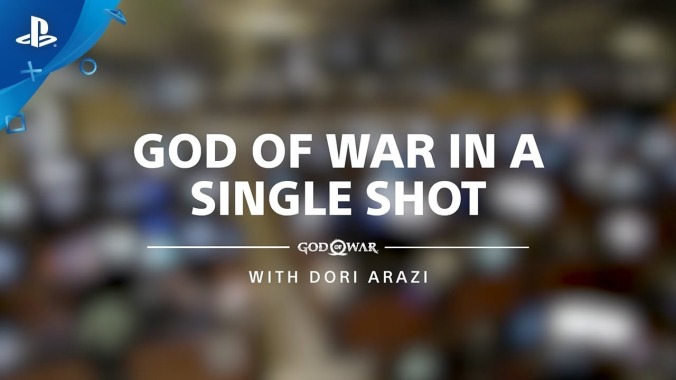God Of War declares its cinematic ambitions with an incredible super-powered fistfight

As far as corporate talking points for video games go, it’s unusual for a publisher to tout that its action epic is presented as if it were shot in one continuous take. Boasting about the sheer size of a game’s world and the dozens of hours of stuff to do in it? Sure. Shouting to the masses that its battles are tense and bloody? Naturally. But hyping up one of the biggest releases of the year by acknowledging a camera technique? That’s the kind of selling point you reserve for getting film buffs salivating over an arthouse movie, not an incredibly expensive prestige game.
And yet, that somehow became one of the bullet points Sony was throwing around as it marketed God Of War, the new soft reboot/sequel to what used to be one of PlayStation’s flagship series. The game really does nail this one-shot presentation, only breaking from the 30-hour journey of its father and son when you hit a “Game Over” screen or pause to enter a menu. In practice, that means the camera smoothly pans around to transition between exploration, battles, and non-interactive scenes. It even seems to hide cuts at a few very specific points, aping the techniques used in films like Rope and Birdman to obscure transitions.
From a technical standpoint, it’s a mind-blowing feat that must have been a nightmare to achieve, all for an effect some players might not even have noticed if the publisher hadn’t gotten out there and promoted it as one of the game’s big features. That raises the question: Why do it, then? One big benefit, as I saw it, was how the player’s constant attachment for the entirety of this adventure creates an even greater sense of intimacy between them and the father-son duo with whom they’re tagging along.
It also helps give the game a weighty, filmic look and feel that sets it apart from its big-budget brethren. It’s there from the moment you hit start, as the main menu fades away, leaving just the opening scene of Kratos, the game’s star, chopping down a tree his deceased wife had marked as one that should be part of her funeral pyre. The camera pulls in tight to give him a rare moment of grief as he solemnly puts his palm to the bark, then pulls out to show his full figure and follow the swings of his ax, each one growing more furious. Here, the camerawork is giving us one long, unbroken look at the emotions swirling in this tired, self-hating demigod, a bit of the inner conflict the game will continue to stew over for its entirety.
And not long after that, the game goes and uses its first major fight scene to remind us that it’s not all going to be close-quarters zombie-slicing battles and a surly old man looking sad. No, this is still God Of War, and it’s going to be filled with some moments of dizzying spectacle—only this time, it’s filmed with the cinematic flair of an ostentatious one-shot set piece. And it’s with this super-powered fistfight between Kratos and a tattooed stranger that God Of War digs in its heels and demands you start taking this no-cuts thing seriously.
Their verbal spat escalates immediately, with The Stranger walloping Kratos and sending him flying over his house. The camera makes its first jarring move, following the Spartan hothead as he bounces off the cabin’s roof and crashes to the ground, getting in tight enough to show his grimace and the rubble kicked up by force of his impact. From there, the game delivers the first of many transitions between watching the fight and taking part in it. Here, The Stranger jumps into frame, dominating it until the camera pulls out and reveals the two warriors to be standing in the perfect mano-a-mano stare-down for kicking off a boss fight. Later, The Stranger will deliver unavoidable attacks that shift the game back into non-interactive scenes, wildly choreographed sequences that see Kratos and his challenger flung through trees, boxing at superhuman speed, and stampeding through his house. The camera is there every step of the way, flawlessly connecting the anime-flavored fisticuffs to all the little gameplay bits and always framed up to portray every ounce of the destruction in these blows and every disgruntled frown on Kratos’ bloodied face.
First impressions, especially for concepts this daring, don’t get much better. One’s taste for the look of these scenes may vary depending on personal feelings about movies with shaky-cam visuals, which God Of War emulates—albeit with a gentle touch and without all the lightning-quick cuts of something like The Bourne Identity—but this scene alone makes good on the game’s “one-shot” promise. It seamlessly stitches together a boss fight and a badass action scene into a single 15-minute sequence, peppering in a few eye-popping shots and even slow moments that allow some character nuance to sneak in, like when The Stranger punches a hole in Kratos’ roof and, concerned for the safety of his son who’s hiding in the house, he and the camera take a second to peer inside. For a game that’s trying so hard to blend bombastic fantasy action with a strong emotional center, being able to meld all these elements together is essential. And remarkably, God Of War keeps it up for dozens of hours more.